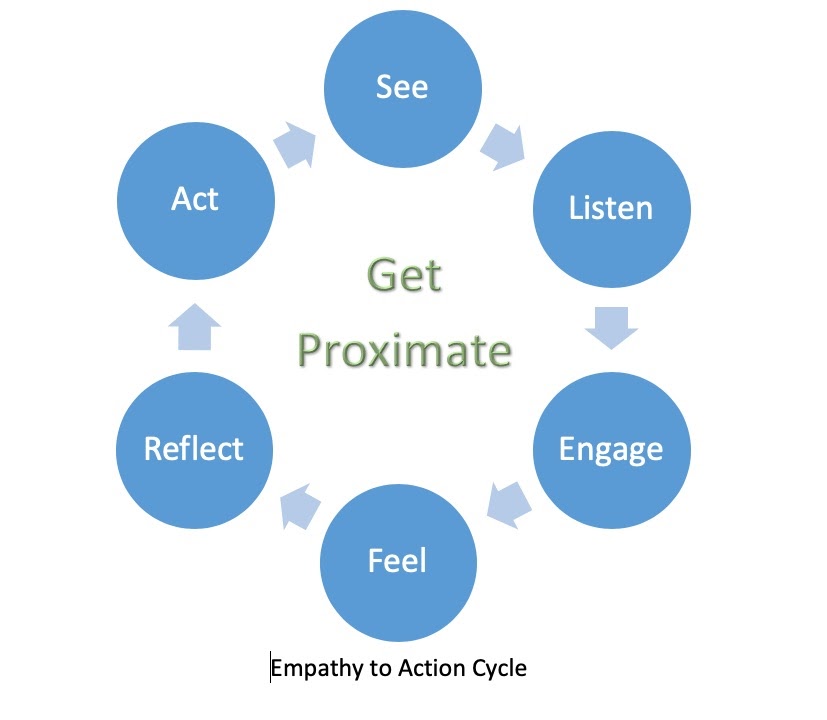By Kelly Pope, SV2 Get Proximate Co-Lead, SV2 Partner
Silicon Valley is a region whose stories and narratives are as diverse and complex as its residents. Home to some of the highest concentrations of wealth and education levels in the nation, disparities have also given rise to sharp increases in hunger and homelessness, especially among families and children. Communities of mansions are within a few miles of multiple families living in small single family homes and despite a boom in construction, demand and cost have far outpaced supply and financial means. The region is home to some of the best universities and school districts in the country but also a place where reading at grade level or accessing basic classroom resources is a challenge for far too many children. When some people talk about long work hours, they talk about a job that also throws in perks such as around the clock food, on-site gyms, and even laundry services. But for others, equally long hours mean shuttling in heavy traffic over long distances for multiple jobs at minimum wage, often without benefits, just to make ends meet. While COVID-19 has altered life for everyone, it has deepened the insecurity for populations who were already struggling with these challenges.
Both of these Silicon Valleys work, play and exist side by side and each reflects vibrant and dynamic communities. But these communities are segregated along economic lines which also reflects another reality of the area: wealth is predominantly concentrated in the hands of whites and Asians while LatinX, African Americans, Native Americans or recently arrived immigrants make up the majority of residents in the less affluent neighborhoods. Interactions between the two are primarily transactional. Vastly different realities and systemic influences allow some to thrive economically with access to opportunity, while others face obstacles simply by virtue of their zip code or race. When you peel back the layers of the prevailing narrative that success and affluence abound in the Silicon Valley, you find a harsher truth. It is that even though many work hard and do all the right things, systemic inequalities and disparities are barriers that deprive them of ever ‘making it.’
“If you live and work in Silicon Valley, you may take affluence for granted because it permeates daily life. You may think that with so much growth, everyone’s boat is rising. But you would be wrong.” [The Giving Code]
Beyond Single Narratives
To better understand the communities and people in our area, two years ago SV2 launched the Get Proximate pilot. As learners and funders committed to creating opportunities for everyone to thrive and to affect better outcomes, this journey was about deepening our learning and seeing through a different lens: one that is led by community voice and experience where SV2 Partners are humble witnesses and participants.
It is not a new concept. Bryan Stevenson lays out a framework that addresses today’s inequalities and incomplete narratives; in his view, we must get “proximate” to those in need in order to better understand their experiences. Stevenson speaks with forceful passion as he remarks:
“if you are willing to get closer to people who are suffering, you will find the power to change the world.“²
At the core of getting proximate is engaging in multi-faceted dialogue, learning and reflecting with leaders and residents of local communities, and acting through this informed lens. Jointly designed experiential exchanges allow us to get close, or proximate, with those with whom we don’t normally cross paths and listen to voices we don’t always hear. Getting proximate is both physical and emotional. It is humbling to bear witness to other people’s circumstances, listen deeply to their stories and then engage in authentic dialogue to learn more. It may mean feeling deeply uncomfortable in the process, either by going to places we haven’t been to before or hearing and seeing things that are new and revealing. It means confronting truths that are painful, about ourselves and our societies. Getting close allows us to see a broader picture and tell a more accurate story. In doing so, we see individual and community potential, better understand the assets and strengths that allow communities to be responsive and resilient, and, together, begin to imagine solutions for systemic change and positive outcomes.
As we move forward from pilot to embedded practice, we place greater emphasis on understanding root causes so that systemic issues can be better addressed and acted upon. In the words of Jackline Novogratz, CEO of Acumen:
“Empathy without action risks reinforcing the status quo”. She goes on to say that [empathy] is, “… built from the bottom up and grounded through immersion in the lives of others. It involves connecting on a human level, analyzing the systemic issues at play, and only then envisioning how to go beyond applying a Band-Aid to making a long-term difference.” ¹
Sv2’s Get Proximate Initiative has an underlying theory of change: Empathy to Action. It is guided by curiosity and learning which leads to deep empathy. We define empathy as the capacity to understand or feel what another person is experiencing through a better awareness of their perspectives and life realities. This approach predicates that by better understanding alternative narratives and systemic issues that communities grapple with, we better understand our role as partners and the actions needed to change systemic inequalities.

The Empathy to Action cycle requires us to See, Listen, Engage, Feel, Reflect and Act. By going through these steps to gain a deep understanding of what is, we move to a heightened commitment to empathy which then leads to action. Action, individual or systemic, is based on a shared vision of equity and justice that allows everyone to thrive. The shifts in perspective that take place after getting proximate will likely transform not only local giving but how people navigate their roles as community members, donors, and leaders more broadly.
See: Notice with interest with the eyes, mind and heart/Observe with curiosity/Look for the hidden or less visible
Listen: Actively listen to words and sounds around you/Hear without judgment/Hear different voices and stories
Engage: Interact with humility and curiosity/Capture fresh insights
Feel: Deeply relate to and identify with suffering/Experience new emotions
Reflect: Thoughtfully consider new understandings and meanings /Integrate and absorb
Act: Modify previous behavior to influence positive change/Transform live and systems by action
Get Proximate: A New Tool for SV2
For SV2, getting proximate is a critical lens through which to see an individual’s or community’s potential, to recognize the existing disparities, and to seek solutions. Getting proximate is a way of being and a set of values that impact interactions with anyone or anything you seek to know better. In fact, SV2 believes it is a core competency in the philanthropic tool-kit, much like being able to analyze financial statements or understand strategic plans. In conjunction with Diversity, Equity and Inclusion work, SV2 is looking at how we can embed the principles of getting proximate in all of our work. We will go more deeply in our learning sessions, grant making and impact investment to learn the root causes and the systemic challenges to equity and justice as well as the levers for eliminating them. By bringing in more grantee and community voices to our learning opportunities and strategic discussions, we will create deeper learning as well as leading with best practices for Partners to emulate in their other philanthropic activities. Our three year commitment to partner and learn alongside the North Fair Oaks community will allow us to to learn about community assets and solutions from multiple perspectives across a range of intersecting issue areas.
Silicon Valley is in some ways a microcosm of the promise and the challenges of the United States itself. The depths of inequality and disparity were already starting to permeate the regional consciousness and this has only been accelerated with COVID-19 and the racial justice movement. Locally and nationally, there is a growing recognition that addressing deep rooted systemic inequalities which exclude and oppress cannot be put off any longer. Challenges that affect one community in the end affect us all and barriers that keep us separate are permeable and need to be torn down.
2020 has tested us as never before, but there is cause for cautious optimism. As communities across the country grapple with multiple social issues, we are being challenged to reflect on who we are and what we want to be. In our increasingly diverse nation – socially and economically — our communities are full of assets, resilience, grit, strong work ethic, innovation and creativity. Though there are those fighting to preserve the status quo, there is a bigger social and political movement that seeks to harness the power of this time for the good and benefit of all and so that everyone can thrive to their fullest potential. Moving in this direction will require learning to listen deeply, be in empathy with the community and act together to make the changes we desire.
To keep current with Get Proximate activities and information, please join the Get Proximate community on mySV2 (for SV2 Partners). For any questions about Get Proximate, please contact Paru Desai.

